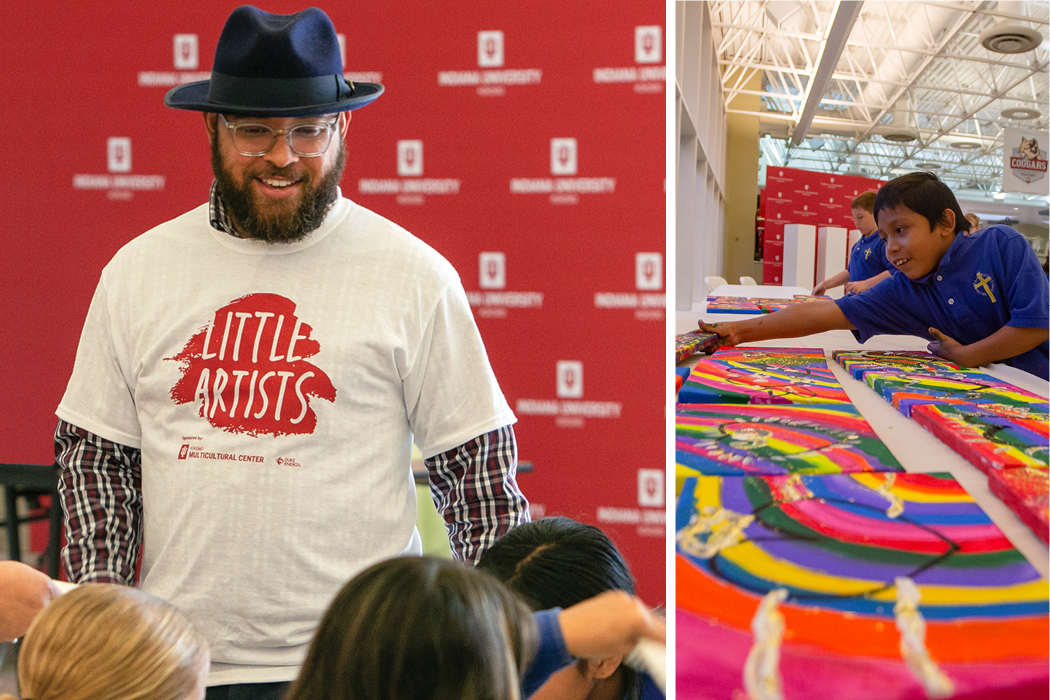Paper Architect
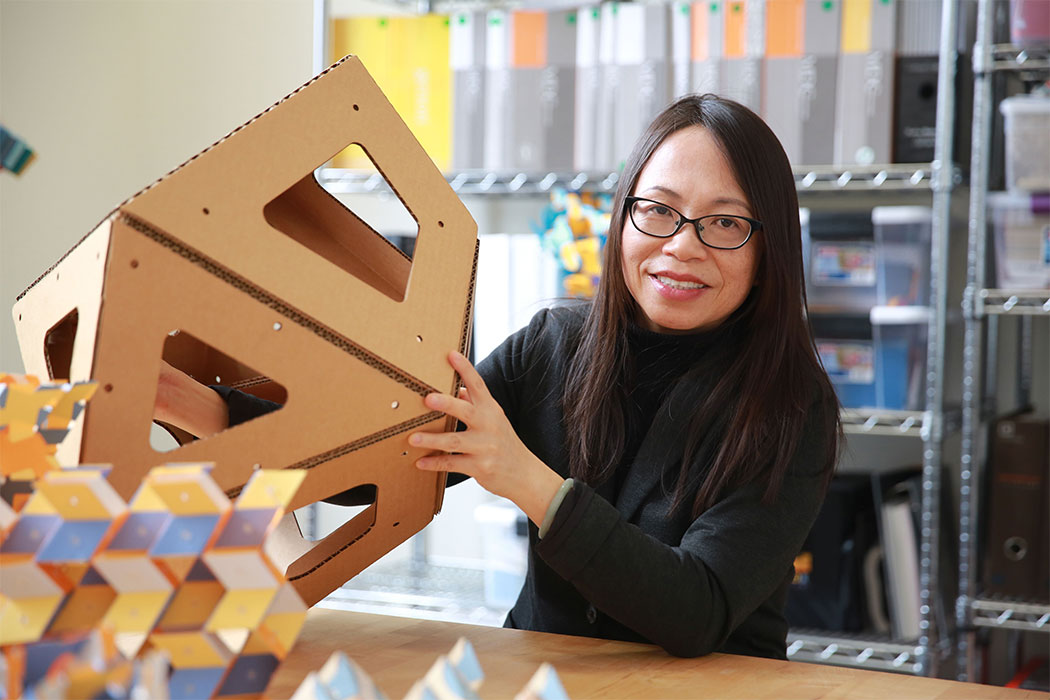
The word “origami” usually conjures images of delicately folded paper cranes, flowers, and sailboats. What it doesn’t immediately bring to mind is building-size structures that can shelter and support human beings.
Yet, that is exactly what Jiangmei Wu, MS’96, MFA’09, an assistant professor in the School of Art, Architecture, and Design at IU Bloomington, has been working to create for close to a decade. Her large-scale, origami-inspired installations have captured the imagination of critics and art lovers all around the world.
Wu grew up in China and knew from a very young age that she wanted to pursue creative and artistic endeavors. Her first passion was architecture. So, she attended college in Shanghai, where she received a bachelor’s degree in urban planning and design from the College of Architecture and Urban Planning at Tongji University in 1989.
She came to Indiana University in the early 1990s as a graduate student and completed a master’s degree in interior design from IU in 1994. Then she worked in IT for close to a decade before completing an MFA in graphic design in 2009.
Around that time, she saw Between the Folds, a PBS documentary film about origami: “I was like, ‘Oh, my gosh! This is what I want to do,” she says.
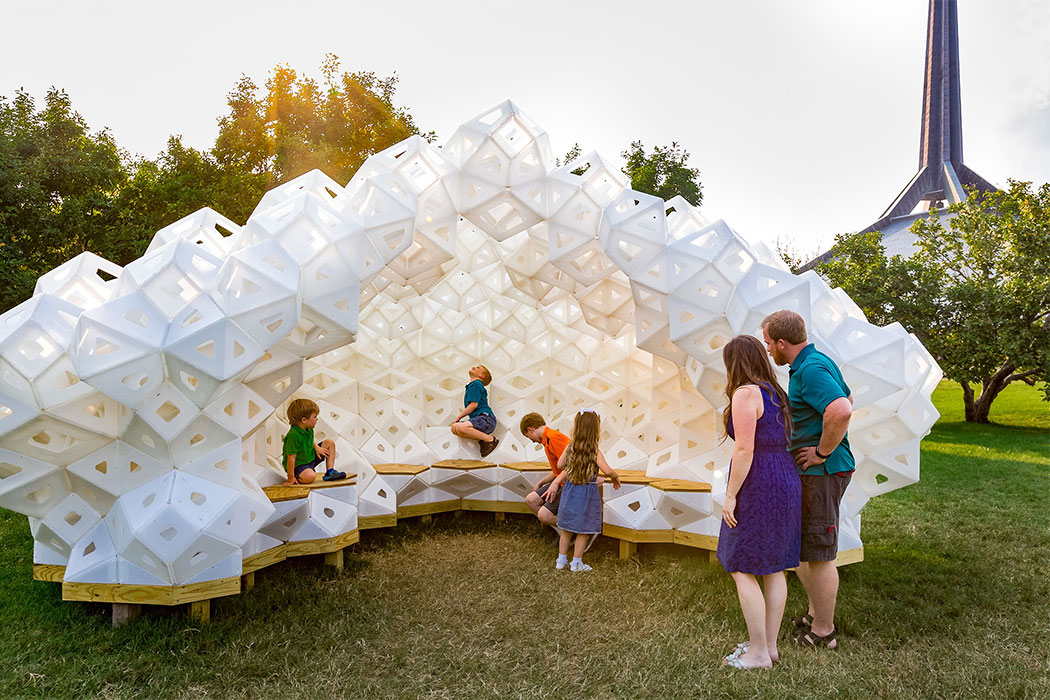
Pride interviewed Jiangmei Wu in her office in Kirkwood Hall on the Bloomington campus in December.
Tell us a little about your time as a student at IU. Did you always plan to become an artist working with paper?
When I was going through the MFA program, I was working full time while trying to finish my degree. I realized that by the time you finish an MFA, you need to identify yourself as a unique artist. You need to have something that is unique, so other people know who you are. That’s very important. You need to develop your own thing—a style that is uniquely yours.
During that time, I started to tinker with origami, folding a little bit. I work with paper because in graphic design I got to learn about all different types of paper, how to work with letter prints, hand prints, silk printing, all that kind of stuff, and I also got to know about making artist books. So, my MFA project was about making an artist book, but instead of cutting the paper, I folded the paper. I compacted down, and I started to mess with the folding a little bit.
I thought that [my project] was really well received. I got a sense that that’s me. That’s what I can do.
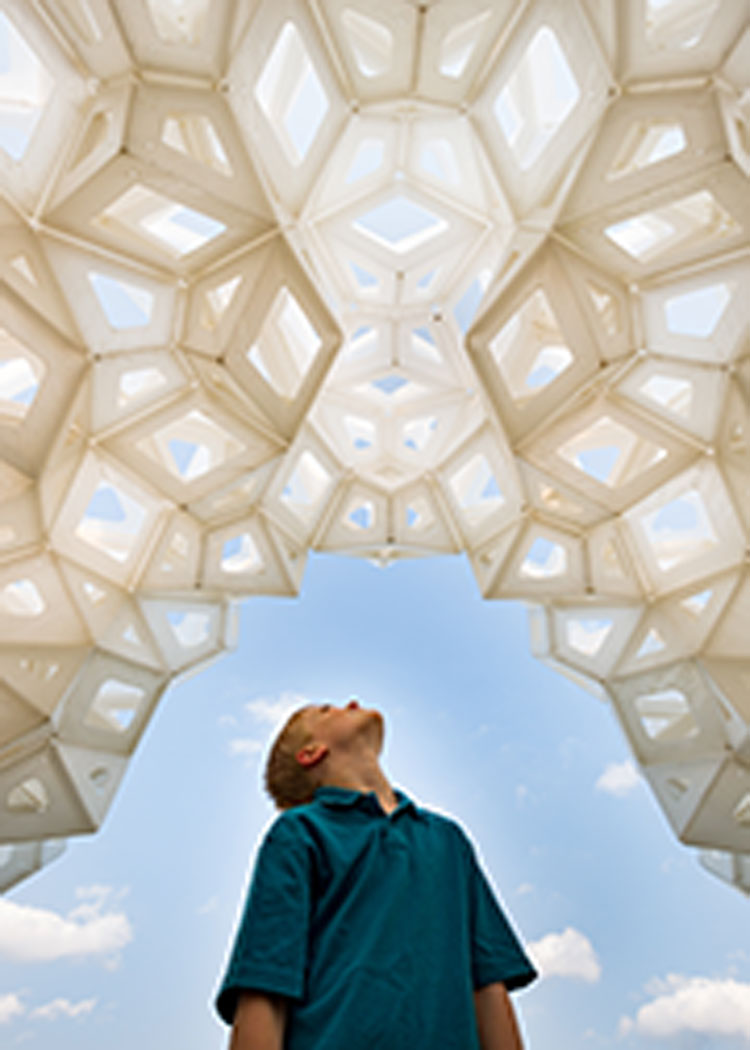
Your interest in origami was something that developed when you were a little older, as opposed to something you developed in childhood, right?
Well, yes. But it’s all kind of linked back to my childhood as well because I always knew about origami. My mom taught me origami. We just had baskets and baskets of models at home, making all kinds of little models. So, it was always in me.
I’m interested in the science and mathematics behind origami. The movie [Between the Folds] was like, “Boom! That’s it. That’s what I want to do.” But that was actually after my thesis. I started to do a lot of internet research, and when I started to learn about this different technique, that’s how I got started. I started to produce my first collection which was all paper stuff, folded live.
I submitted my work to MOCO LOCO, a design blog. By chance, they accepted my work and it got published. And pretty soon, one of the curators at designboom, one of the most well-known design blogs, contacted me and wanted me to participate at their group show in New York. Once that got going, I had people contact me, people inviting me to show. Everything got started from that point on.
Are there many other people working with the kind of materials and the kind of styles that you’re working in?
Now there are. I was very lucky. My name was out there, and next thing I know, I’m contacted [by] this very well-known curator who had been doing origami shows. I said, “Take a look at my work.” She just happened to like it and got me connected to more big shows, made me create larger works, bigger scales, and that’s all just [how it] happened.
I was struck by the piece, Synergia, that you did in Columbus, Indiana, which is a beautiful city architecturally. Synergia is perfectly aligned with the context of the city, especially so close to Eero Saarinen’s well known North Christian Church?
We wanted to be part of [Saarinen’s] building. Sort of taking the essence, the inspiration, and moving on.
We used plastic material, recycled plastic, that can be recycled after a few months. It was out there for most of the year. What is interesting is we pretty much fabricated the entire thing here in this building [Kirkwood Hall on the IU Bloomington campus].
What we did is we put it together first in one of the classrooms. We didn’t really have studio space here, so we put it in a classroom during the break when the students are not here. The classroom has small doors, so everything was built by hand. Fabricating and cutting and putting it together, and building and testing; building the whole thing inside to make sure everything works. And then, moving it out and trying to figure out how to fit it through the doorway. It was a lot of fun.
So how did you break it down and then reconstruct it?
Each [piece] of this unit was folded from a flat sheet of material and then laser cut. Then, we scored the material and we folded and put it together into a polyhedron. Nobody had done this before, so the scary part for me was, of course, the structural possibilities. Was this strong enough to withstand the outdoor weather? Storms and everything. It’s just a very thin piece of plastic.
How did your piece Light Harvest come about? It looks like a helix, like DNA. Was that another offshoot of your interest in science?
An offshoot, yes. As I say, the reason that origami fascinates me is because it doesn’t just [follow the principles of] man-made things. It is actually something that nature does.
One day I was out hiking with Susanne Ressl, an assistant professor of biology at IU. We just happened to be talking and trying to figure out what each other does for a living. She said she was interested in art, [so] I started talking to her about it. She does crystallography. The next thing you know, I went to her lab and looked at her work, and then we just clicked and said, “Let’s work on a project together.” So that’s how it came about, that collaboration.
I am so happy to have done that project. It’s really amazing because the protein that we chose to work on is one of the most important proteins, really. The light-harvesting complex is amazing, it takes solar energy and converts it into chemical energy.
I’m interested in this cross-pollination of different disciplines. You’re an artist who has worked with engineers, mathematicians, biologists, etc.
To understand what other disciplines do—that’s really, really mind-blowing. The resources we have here [at IU] are just incredible. And, the opportunity to work with really world-class faculty here on campus is really amazing. This morning I was talking to a mathematician, Matthias Weber, just to pick his brain. We’re working on a project together.
This [project] is also about folding, but this time we are looking at three-dimensional folding. The piece is called Butterfly. We use a kind of weaving technique. You can fold it completely in [one] direction and then you can also fold it in a different direction. It has the ability to compress in both directions. We don’t know yet the implications for this, exactly—how people will use this.
[Weber] said that, without me, he would not think about issues like this. Without him, I wouldn’t exactly understand the math. I know the mathematics, but it’s all just rudimentary, nothing [that can] compare with mathematicians. It’s just really amazing.
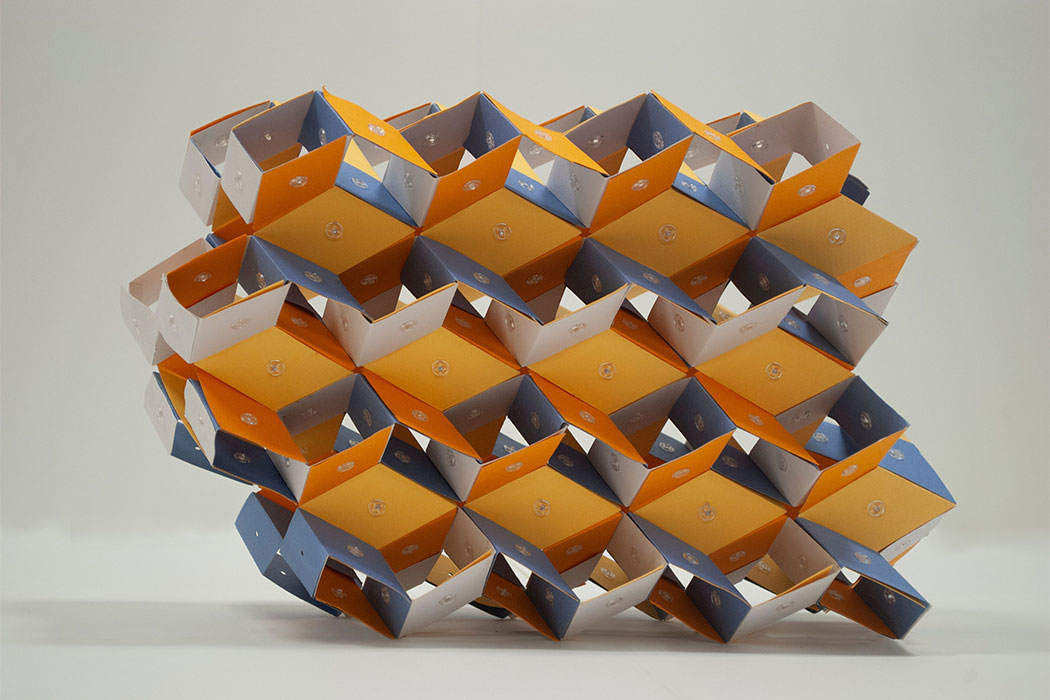
Even on a less functional level than what you’re describing, what you are doing still exists as art on its own. It’s still beautiful to look at.
It is beautiful to look at. But it’s very complicated. I was drawing this pattern, and I said, “Look! This is zero, one, zero, one—like a spiderweb pattern.” In some way, these patterns all combine. They all match with each other. We are just trying to study, why—Why [do they] match? What makes it all match?
I’m not a mathematician, but I love mathematics. It helps me. It’s useful for my work. The thing about mathematicians that is really fun is that they make things. They break down complex things like this into something really simple and general, and they try to understand the most general case. They gradually build a complex one. I work the other way. I go to the most complex and specific stuff. Intuitively, I want to see if it works. To make sure it works first. Then, [to understand] it, you have to start with something really simple. For me, I always try to make things complex. Look complex. Appear to be sophisticated because beauty [is] associated with sophistication.
You seem like a person who can see the interconnectivity in things—in nature, the human body, the environment around us.
I think ultimately [it is] very important for us to understand that interconnectivity. Also, [it] is important for researchers from different disciplines to come and talk to each other. Collaboration is not an easy thing. It’s really not easy. Because you come from completely different domains, and you speak different languages. Really, [you have] to have good communication and understanding and be able and willing to work through the hurdles.
How has being here at Indiana University impacted your work, your research, your artistry?
I think IU provides me with great resources. As a faculty member in the College of Arts and Sciences, I have access to a variety of grant opportunities that allow me to pursue my research—and also, to the faculty around me. It’s the most incredible resource.
Your work sounds very engaging and it obviously keeps you mentally stimulated?
It piques my intellectual curiosity. I really don’t need much to drive this. I want to work every day, want to get up every day, and want to be happy every day, and this is really interesting to me still.
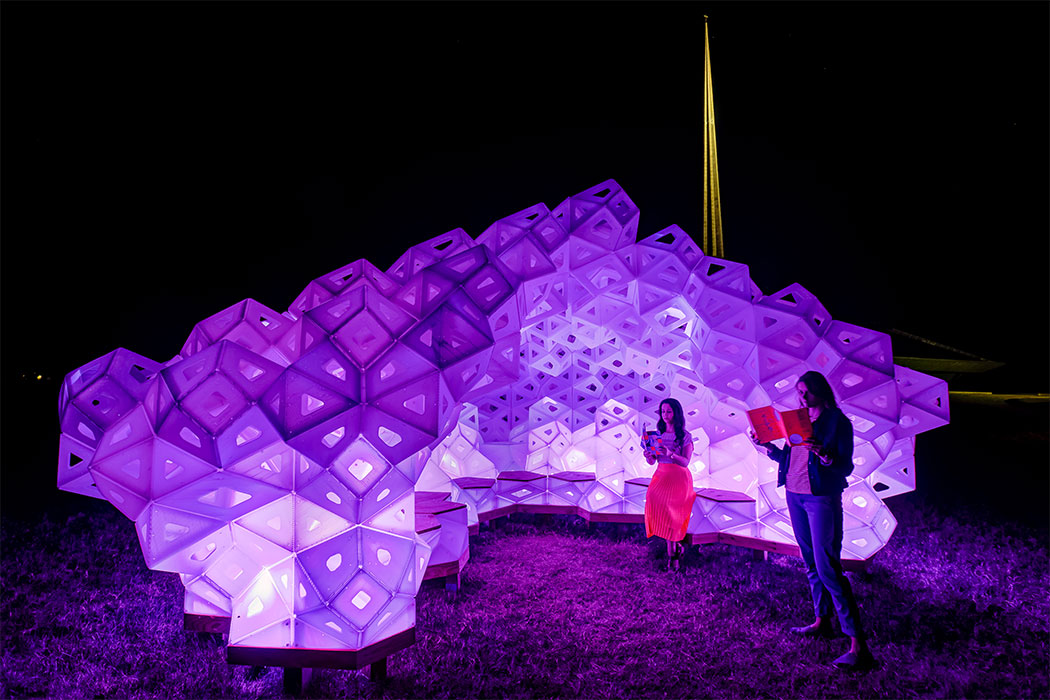
Paper Architect appeared in the Original section of the Summer 2019 issue of the IU Alumni Magazine, a magazine for members of the IU Alumni Association. View current and past issues of the IUAM.
Original shines a spotlight on the works, talents, and interests of IU alumni across the globe. Have something unique worth sharing? Let us know at iueditor@iu.edu.
Tags from the story
Written By
Bill Elliott
Bill Elliott, MA’84, PhD’99, is a content specialist at the IU Alumni Association and an associate editor of the IU Alumni Magazine. He enjoys sharing amazing stories about IU alums from all around the world.



